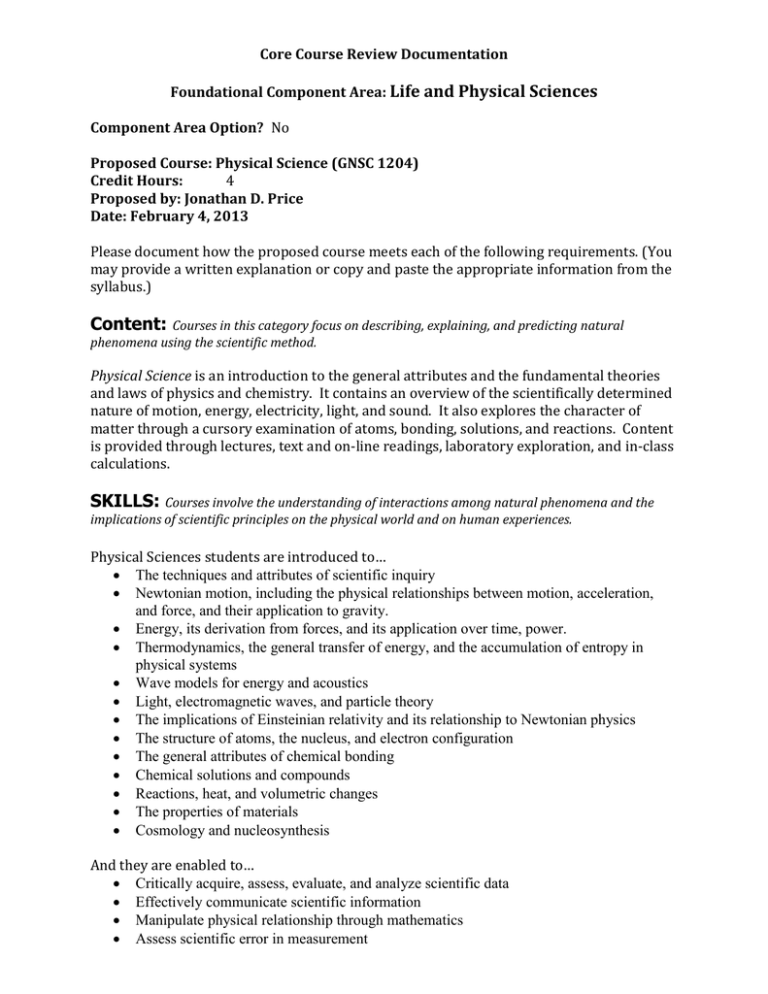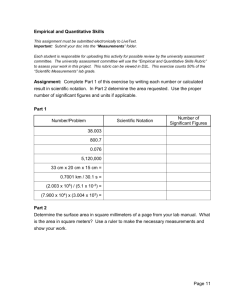Life and Physical Sciences
advertisement

Core Course Review Documentation Foundational Component Area: Life and Physical Sciences Component Area Option? No Proposed Course: Physical Science (GNSC 1204) Credit Hours: 4 Proposed by: Jonathan D. Price Date: February 4, 2013 Please document how the proposed course meets each of the following requirements. (You may provide a written explanation or copy and paste the appropriate information from the syllabus.) Content: Courses in this category focus on describing, explaining, and predicting natural phenomena using the scientific method. Physical Science is an introduction to the general attributes and the fundamental theories and laws of physics and chemistry. It contains an overview of the scientifically determined nature of motion, energy, electricity, light, and sound. It also explores the character of matter through a cursory examination of atoms, bonding, solutions, and reactions. Content is provided through lectures, text and on-line readings, laboratory exploration, and in-class calculations. SKILLS: Courses involve the understanding of interactions among natural phenomena and the implications of scientific principles on the physical world and on human experiences. Physical Sciences students are introduced to… The techniques and attributes of scientific inquiry Newtonian motion, including the physical relationships between motion, acceleration, and force, and their application to gravity. Energy, its derivation from forces, and its application over time, power. Thermodynamics, the general transfer of energy, and the accumulation of entropy in physical systems Wave models for energy and acoustics Light, electromagnetic waves, and particle theory The implications of Einsteinian relativity and its relationship to Newtonian physics The structure of atoms, the nucleus, and electron configuration The general attributes of chemical bonding Chemical solutions and compounds Reactions, heat, and volumetric changes The properties of materials Cosmology and nucleosynthesis And they are enabled to… Critically acquire, assess, evaluate, and analyze scientific data Effectively communicate scientific information Manipulate physical relationship through mathematics Assess scientific error in measurement Learning Activities: Sample activities through which students will learn the skills and objectives for this course include the following: Readings in the textbook and on-line documents Lecture and interactive information Short written laboratory assignments including applying scientific methods to earth materials and processes (critical thinking and communication objectives) Calculations on scientific measurements (empirical and quantitative objectives) Laboratory evaluation of physical phenomena and chemical properties (empirical and quantitative and critical thinking objectives) Opportunities to attend related presentations on campus or in town related to topics in the class; varies by semester but typically includes Speakers and Issues Series, Artist-Lecture series, and Faculty Forum. ASSESSMENT OF CORE OBJECTIVES: Assessments should be authentic, intentional and direct. The following four Core Objectives must be addressed in each course approved to fulfill this category requirement: Each assignment and evaluation in this class touches on the core objectives. I have selected and attached one activity, a lab on centripetal force that provides reasonable exposure to all (see attachment). In each case, the course will use an AACU rubric for assessing each objective. The proposed course is first-year (1000) level; all passing students should meet or exceed the milestone level 2 of each assessment rubric, with the exception of the teamwork rubric, in which passing students are anticipated to achieve or exceed level 1. Critical Thinking Skills - to include creative thinking, innovation, inquiry, and analysis, evaluation and synthesis of information The course assesses critical thinking skills through evaluations (quizzes, journals, and examinations) and laboratory exercises. Students manipulate and utilize presented information and acquired data in these evaluations to assess physical and chemical systems. The attached laboratory requires students to perform three experiments using a rotating-arm apparatus. Each experiment is repeated three times, in which students evaluate the repeatability of the experiment. The students use these data to perform straightforward calculations. Students are then required to make comparisons to additional data, evaluate scientific error, and comment on their findings. The specific assessment of critical thinking skills is a detailed question in the lab write up question 3 on p. 23, which regards the causes of analytical error. The question is rooted in the repeatability of the experiment and the nature of deviation of the measured value from that predicted by applying Newton’s second law to revolving bodies. Students are required to evaluate the limitations of the equipment and their ability to accurately measure the parameters in the experiment. The students’ work will be assessed using the attached AACU Critical Thinking VALUE Rubric (two rows of the rubric will be used: explanation of issues and conclusions and related outcomes). Communication Skills - to include effective development, interpretation and expression of ideas through written, oral, and visual communication Students develop communication skills through written answers to laboratory exercises, journal entries, and interactions with instructors. The attached laboratory exercise on centripetal force requires students to provide well-reasoned and well-written answers to inquiries on the relationships between mass, radius, and centripetal force. Communication skills assessments are based on the paragraph form questions (1 and 2) on p. 22-23. The questions require students to relate the results of the experiment and the nature of angular motion. This requires students to communicate the attributes of the measurements and the calculations. The students’ work will be assessed using the attached AACU Written Communication VALUE Rubric (two rows of the rubric will be used: content development and control of syntax and mechanics). Empirical and Quantitative Skills - to include the manipulation and analysis of numerical data or observable facts resulting in informed conclusions The students develop empirical analytical skills and quantitative skills through assigned readings, an evaluation of the data presented in lecture, and laboratory activities. Both readings and lecture slide sets frequently introduce the methods and data that underpin our current scientific understanding of the universe. The laboratory exercises provide opportunity for further application and ultimately assessment of these skills. The attached laboratory exercise requires students to directly observe a robust physical system, acquire data, and manipulate calculations to evaluate how the system is affected by changes in variables. The attached lab requires students to revolve a mass around an axis, carefully counting the rotations over a timed period. From the measurements students are required to calculate the centripetal force as evidenced by the measurable parameters on the apparatus and timer. They are further required to compare their instrumental measurement to a direct measurement of the centripetal force based on the weight of the object. The students’ work will be assessed using the attached AACU Quantitative Literacy VALUE Rubric (one row of the rubric will be used: calculation). Teamwork - to include the ability to consider different points of view and to work effectively with others to support a shared purpose or goal Teamwork skills are developed through group work in laboratory. In this setting, students work together in small groups to acquire data, discuss and execute calculations, and answer questions. The attached exercise requires students to work in groups of four, primarily to share the limited equipment, but also to divide the labor for measurements. The attached lab on centripetal force has several exercises that require a degree of teamwork. Individual students will undertake specific parts of the exercise: timing, counting, and data recording. The group effort culminates into an individual report. Each student is required to provide an original answer to each of the questions on page 22-24. The students’ work will be assessed using the AACU Teamwork VALUE Rubric (two rows of the rubric will be used: Contributes to Team Meetings and Individual Contributions Outside of Team Meetings). ADDITIONAL INFORMATION: Provide any additional information supporting course inclusion in the core (optional). PLEASE ATTACH THE FOLLOWING 1. 2. 3. 4. 5. Syllabus Assessment for Critical Thinking Skills Assessment for Communication Skills Assessment for Empirical & Quantitative Skills Assessment for Teamwork

